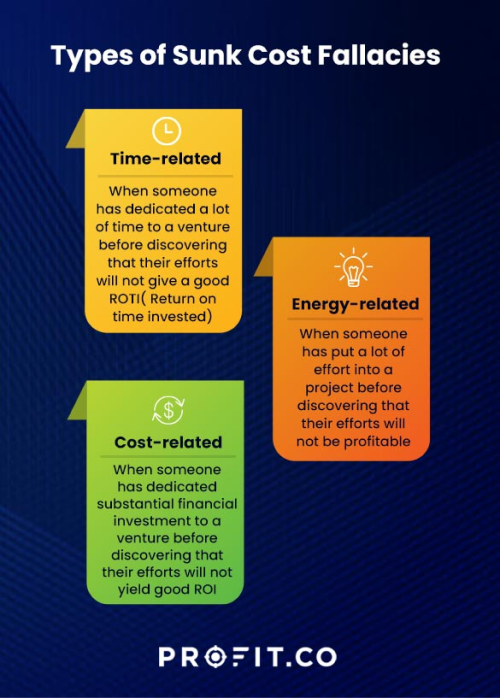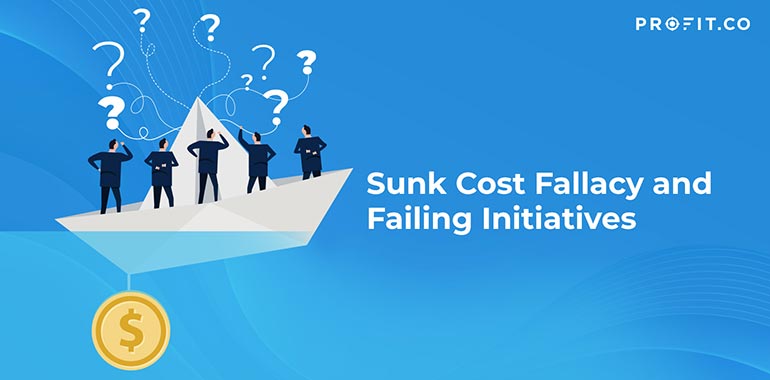The sunk cost fallacy is our habit of continuing a project we invested in, even when the downsides outweigh the benefits. We can invest time, effort, or finances.
Introduction
Let’s say you purchased a ticket to a movie premier four weeks ago for $500. On the premiere night, you discover it’s pouring outside, and you’re feeling unwell. That means traffic will be crazy due to rain, and your presence in the theater will not do your health any good.
Let’s be honest, aren’t you still likely to go to the theater, despite knowing that the downsides outweigh the benefits?
The sunk cost fallacy definition is this exact tendency. You are more likely to continue with something if you commit to it effort-wise, time-wise, and financially. You choose to ignore evidence that pursuing the course is no longer ideal, like with the bad weather or sickness in the above example.
When you give in to the sunk cost fallacy, you tend to make unreasonable decisions that don’t favor your best interests. You keep digging a deeper hole, and sometimes you are aware yet can’t stop yourself.
In this article, we’ll discuss sunk cost fallacy, how to recognize it, and how to avoid it altogether.
What is Sunk Cost Fallacy?
In business, a sunk cost is an impossible investment to recover. If your business incurs a cost and there’s no possibility of recovering it, that cost is “sunk.”
For instance, you can assess your business and note that creating a new trendy marketing campaign or buying expensive software may be beneficial.
When making that investment decision, you have optimistic predictions and hopes for the future. However, even promising investments can fail, so what would you do if you get disappointing results? You can choose to cut your losses or continue with the course in hopes of better outcomes and losing more money, time, and effort.
In such a case, the best move for the business would be to accept the loss and abandon the investment. Continuing with investment is an example of giving in to sunk cost fallacy.
While dealing with sunk cost fallacy and decision making business leaders must not fall prey to Cognitive Biases that plague decisions. This can lead to decision fatigue.
OKRs can help avoid Decision Fatigue. At the center of OKRs are focus and alignment. Once you set your objectives and align them with measurable key results to track your goals then let your OKRs guide you through the quarter. Book a free demo with our team to learn more about how OKR software can optimize your organization’s performance by helping with decision-making.
Definition and Types
The sunk cost fallacy primarily happens because our emotions sometimes prevent us from making rational decisions.
Deserting a venture after committing and pouring resources can cause feelings of loss and guilt. You may keep the course to avoid such feelings, even when it doesn’t support your best interests.
There are different types of sunk cost fallacy, including
- Time-related Sunk Cost Fallacies
A sunk cost fallacy can happen when someone dedicates much time to a venture before discovering that their efforts will not help achieve their goal. They are likely to maintain course without any returns, even if the sensible thing is to move on. Your ROTI (return on time invested) indicates that the project or activity will not bring about a positive impact.
It’s like putting together a furniture piece and then realizing you made an error halfway through. Instead of undoing one hour of work to correct the mistake, you continue building incorrectly.
In another example, let’s say a student pursues a bachelor’s degree for two years and then loses interest in the major or develops a new interest. Instead of giving up the two years they already spent, they continue pursuing the unfulfilling major.
- Energy-related Sunk Cost Fallacies
You might decide to adopt new accounting software to record business expenses. You train the accounting and finance teams on the new system for several months.
During the training process, you discover that the new system is unsuitable for your needs. Instead of ceasing the training and switching to a different approach, you stick to the ineffective software. Finance departments have to assess and gauge the expenses, revenue, and cash flow of the company as a whole. Consequently, they have to be accountable for analyzing the financial health of individual departments.
- Monetary Sunk Cost Fallacies
You can also recognize a sunk cost fallacy after substantial financial investment. For instance, you can buy a house to upgrade and improve the property and sell it for a profit.
After using $20,000 on remodels, you discover that the area is less prime than you thought. Instead of acknowledging the sunk cost and abandoning the poor investment, you proceed with the upgrades and spend more money. Your ROI (return on investment) will not be profitable.
In such a case, you lose money, energy, and time. This shows that most matters of sunk cost fallacies simultaneously impact multiple resources. Finance departments have to assess and gauge the expenses, revenue, and cash flow of the company as a whole to avoid falling prey to sunk cost fallacies. One way to ensure this is to have finance KPIs as part of strategy and goal setting in the organization. This helps to keep track of financial goals. Consequently, they will be accountable for analyzing the financial health of individual departments.

Importance of Sunk Cost Fallacy
As with the above examples, the sunk cost fallacy affects multiple aspects of your life. It often causes you to make big decisions with long-lasting effects. You make irrational decisions that have poor outcomes. You focus on past investments rather than current and future benefits and costs. You repeatedly commit to decisions that are not beneficial to your best interests.
The more you invest in this vicious cycle, the more you gain commitment and pour in more resources. You can only break the chain if you recognize it and know how to get back on track.
Sunk Cost Fallacy
Psychological Factors That Cause Sunk Cost Fallacy
According to experts in behavioral economics, several psychological factors promote the sunk cost effect:
- Loss Aversion
Loss aversion is a habit of avoiding losses because losing something has a more powerful psychological effect than gaining it.
For instance, the idea of winning a $100 bet sounds great but losing the $100 will feel worse. Therefore, you’ll do everything to avoid that loss, even if it costs you the opportunity to win.
According to sunk cost fallacy psychology, loss aversion prompts us to continue with poor investments since we’re avoiding feeling bad for losing.
- The Framing Effect
The framing effect occurs when someone chooses an option based on whether they see it positively or negatively.
This effect resonates with the sunk cost fallacy in this way; if you commit to a decision and see it through, you label it as an overall success.
If you fail to follow through, you form a narrative of failure in most cases. You’ll avoid associating with this flawed narrative by trying to stick to the decision, even if the logical move is to cut losses.
For instance, let’s say you decide to launch a blog campaign. After a short while, you discover that the traffic to your blog is below expectations, so it’s better to use the remaining amount for paid advertising.
However, this would mean admitting your blog campaign failed, so you choose to follow through, although spending the money on something else is better.
- Unrealistic Optimism
Unrealistic optimism happens when someone believes they have a lower chance of experiencing an adverse event than others.
This cognitive bias prompts us to overestimate our chances of success while underestimating the chances of failure. In most cases, this happens when you invest finances into a venture.
For instance, if you use thousands of dollars to start a new business venture, you’ll likely believe you have a better chance of success, despite evidence of similar failing businesses.
- Misplaced Personal Responsibility
There is a higher likelihood you’ll fall into the sunk cost fallacy if you feel personally responsible for previous expenses.
It’s easier to rethink a decision someone else made but harder to stop a project you actually invested in. Decision makers and project creators feel this effect most because they are interested in the venture’s success.
Intelligent people make decisions based on opportunity costs.
How Does Sunk Cost Fallacy Affect Decision-making in Organizations?
The sunk cost fallacy goes beyond minor day-to-day decisions. In fact, established companies and governments also fall prey to this vicious cycle.
The Concorde fallacy is a famous example of the sunk cost fallacy effect on large-scale decisions.
In 1956, Supersonic Transport Aircraft decided to build the Concorde, a supersonic airplane. British and French governments and engine manufacturers estimated the project would cost about 100 million dollars.
Before the project ended, they realized the profits from the plane once it started operating would not offset the project’s increasing costs.
Rather than abandoning the project, the governments and manufacturers carried on since they dedicated too much time and finances. They wasted millions of dollars, yet the Concorde did not even last thirty years.
If such high-level executives fell for the sunk cost fallacy, it’s easy to see how we can all experience the adverse effects.
Sunk Cost Fallacy Examples at the Workplace
- Marketing
Generally, businesses advertise their products or services, so a great example is marketing expenses. The costs you incur with advertising or marketing are costs the business will likely not recover.
For instance, let’s say you launched a music streaming service and used $4,000 for advertising and marketing to introduce the product to consumers. The $4,000 already spent will be a sunk cost if the efforts prove ineffective.
The best move is to avoid making further investments in the service and eliminate it from future business decisions.
- Research and Development
Most business owners invest in researching and developing current and future products. For example, let’s say you use $20,000 to create a new hair care product.
After launching the product, only a few consumers show interest in buying your product. The $20,000 you spent is a sunk cost because it’s a failed investment.
There’s no chance you’ll recover the cost, so it shouldn’t affect your decision regarding the project’s fate.
- Hiring
Let’s say you’re a business owner seeking to hire a team member. Since they are promising candidates, the hiring bonus is $10,000. If the employee fails to deliver as expected, the $10,000 is a sunk cost.
Even if you terminate the employee, you won’t recover the hiring bonus.
Identifying and Avoiding Sunk Cost Fallacy
How to Identify Sunk Cost Fallacy; Measuring Your Susceptibility to It
Some common signs can help you recognize sunk cost fallacies, such as:
- Irrational Decision Making
Sticking with a project or venture just because you invested in it may signify irrational decision-making, typical of the sunk cost fallacy.
Data is an ever-powerful tool you can leverage to ensure your decisions remain objective and balanced. If you make a business decision, you can identify measurable metrics to help you determine the success or failure of your decision.
If the metric indicates poor outcomes, you can reduce the risks by adjusting the strategies on time. Make a habit of reinforcing your decisions with objective reasoning. When taking decisions to avoid the sunk cost fallacy it is easy to fall victim to Cognitive Dissonance especially if we have conflicting views about the project.
- Resisting Change
When running a business, it’s common to find people defending inefficient or outdated processes since it’s the traditional way.
Evaluating your company processes to identify growth opportunities to help you retain a competitive edge and avoid sunk cost fallacies is essential.
Embracing change helps to ensure operations remain flexible and innovative. If the conditions change, the company strategies should change as well.
- Fear of Failure
Some people equate acknowledging a poor business decision with admitting failure. Nurturing a company culture that identifies failures as growth opportunities is a great way to defy sunk cost fallacies.
How to Avoid Sunk Cost Fallacy
- Keep your Business Decisions Objective
Making objective business decisions helps you bypass personal attachments and make reasonable decisions.
You can leverage data and identify reliable key performance indicators (KPIs) to ensure you remain on course.
- Set Goals Before Investing
Before investing in a new venture, ensure you determine particular success metrics and set measurable goals. If the venture fails to meet its goals, you can adjust your strategy based on factual data.
- Change your Perspective
Sunk cost fallacies can occur because you have tunnel vision toward your decisions. When determining whether to remain invested in a project, it’s best to have a broader perspective. Managers and leaders should be conscious of cognitive Biases like the representativeness heuristic to be objective in decision-making.
Your decisions should always support your best interests and long-term goals.
FAQs
- What Is the Difference Between a Fixed Coat and a Sunk Cost?
Fixed costs are recurrent expenses the business incurs but don’t relate to the production process. They remain constant regardless of the income you generate.
Sunk costs fall under fixed costs, but they are unrecoverable.
- Do Salaries Count as a Sunk Cost?
Salaries paid out are sunk costs as long as the company can’t recover them.
- What is the Sunk Cost Dilemma?
The sunk cost dilemma implies the challenge of deciding whether to see a project through when you’ve invested in it but have yet to attain the expected results.
Conclusion
Investing your energy, time, or money in a venture doesn’t mean you can never abandon the sinking ship. Recognizing and acknowledging the best time to cut your losses is your best line of defense. Some decisions can cause a domino or a ripple effect that can cause lasting harm. So it is indispensable to understand and make a serious effort to overcome it. So, it is crucial for organizations to carefully consider this and increase self-awareness to defy sunk cost fallacy. You can get started on Profit.co completely free today to learn how your team can learn about OKR software that can help with decision-making and optimize your organization’s performance!

